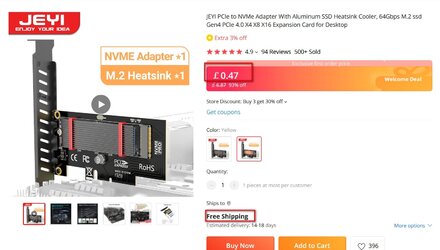Even on this budget mobo there are several pcie slots. If I wanted, I could have at least 3 nvme installed by using a couple of pcie adapters in addition to the single nvme slot.
I am not sure how much of this thread is relevant to the OP. Lets hope his purchase is ok.
My primary concern of shoving in extra PCIe cards to handle NVMe's, is that this does take away bandwidth from your video card your onboard NVMe drives on the mobo. Whether that makes a noticeable difference, I don't know. It's not something I have tried.
Yes, it does. But, when it comes to modern GPUs, a PCIe gen 4 X8 is the equivalent of a PCIe gen 3 x16 bus. And that hardly gets taxed as it is.
First, remember that 1x speeds double for each generation of PCIe thus far:
The speed differences between PCIe 4.0 & PCIe 3.0 are apparent. We discuss those differences in this post, as well as whether to upgrade to PCIe Gen 4.

www.trentonsystems.com
Next, realize also that as the number of lanes doubles so too does the bandwidth, so X16 in any gen is 2x x8 in that same gen.
So, then it becomes a matter of what games are using and what they need.
Direct benchmarks (using the same Ryzen 9 2950X I have installed:
With the launch of the new GeForce 30 series, PCI Express 4.0 performance has come up into the discussion. To find out exactly what we're talking about,...

www.techspot.com
But, some caveats:
An upcoming budget Radeon GPU will be restricted to PCIe 4.0 x4 bandwidth, but what does that mean for gaming performance? Here's a brief investigation on PCIe...

www.techspot.com
The folks over at
TechPowerUp have tested an RTX 3080 with average frame rate performance at 1080p only dropping ~10% when limited to 4 GB/s of PCIe bandwidth. With that being a significantly more powerful GPU, many have assumed the 6500 XT will be just fine. The problem with that assumption is that you're ignoring that the
RTX 3080 has a 10GB VRAM buffer, while the 6500 XT only has a 4GB VRAM buffer. The smaller the memory buffer, the more likely you are to dip into system memory, and this is where the limited PCIe bandwidth can play havoc.
I have a 3080 Ti, and right now, I'd have no issues running that at PCIe gen 4 X8 bandwidth, because I don't think I have a single game that will tax even that x8 bandwidth, and it has 12 GB VRAM (DDR6X).
But, in the future, in order to stay competitive, when games do start making use of the greater bandwidth of PCIe gen 4, it will start to be an issue. I bought my previous video card something like 5 years before I built this system, and though it is 3 years old, the video card is only 1 year old, and I'm not gonna replace it anytime soon. So, for future proofing, not shoving in a bunch of PCIe expansion cards for use with NVMe drives is in my benefit.
Besides, My mobo actually came with one anyway, a 2x NVMe drive AIC - called the M.2 Xpander-Z Gen 4:
It worked - but I then only got to use a single of the older NVMe drives as a portable drive, as these were now in the system, and required a good bit of effort to get out.
And with it in, I did see the GPU drop to 8X, too. Didn't really make much of a difference, even at 4K resolution when gaming - but my desire for 3 portable drives nixed the setup.












